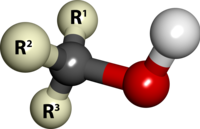
Photo from wikipedia
Abstract Thermochemical ester bond cleavage in the phospholipid phosphatidylcholine (PC) was evaluated at reaction temperatures between ca. 20-60 °C using a series of lithium and zinc halides: lithium chloride, lithium bromide,… Click to show full abstract
Abstract Thermochemical ester bond cleavage in the phospholipid phosphatidylcholine (PC) was evaluated at reaction temperatures between ca. 20-60 °C using a series of lithium and zinc halides: lithium chloride, lithium bromide, lithium iodide, zinc chloride, zinc bromide, and zinc iodide. Hydroxides, produced via reaction between lithium or zinc halides and potassium hydroxide (KOH), attacked and cleaved selective phosphate and carbonyl ester bonds found in PC. Cleavage reaction efficacy was studied over a wide range of reaction conditions, 2 and 4 hours at 21, 30, 50 and 60 °C, using attenuated total reflectance and transmission FTIR (ATR-FTIR) spectroscopy. FTIR spectral analysis of neat (unreacted) and reacted PC showed qualitative and quantitative evidence of carbonyl and phosphonyl ester bond cleavage as indicated by the appearance and increase in the asymmetric carboxylate anion stretch (∼1577 cm-1) and symmetric phosphonyl dianion stretch (∼1010 cm-1) peaks, respectively. Ester cleavage in PC was demonstrated under extremely mild conditions using lithium hydroxide. In addition, the hydrolysis was found to be selective, leaving the zwitterionic phosphorylcholine group intact. Reaction time and temperature had little to no effect in promoting hydroxide attack on the ester bonds found in PC. Finally, the results of this study show that a non-enzymatic cleavage reaction methodology based on lithium hydroxide can be used for selective ester hydrolysis under extremely mild conditions. This ester hydrolysis method allows for a fast, low temperature, and selective cleavage using a chemical catalyst.
Journal Title: Vibrational Spectroscopy
Year Published: 2020
Link to full text (if available)
Share on Social Media: Sign Up to like & get
recommendations!